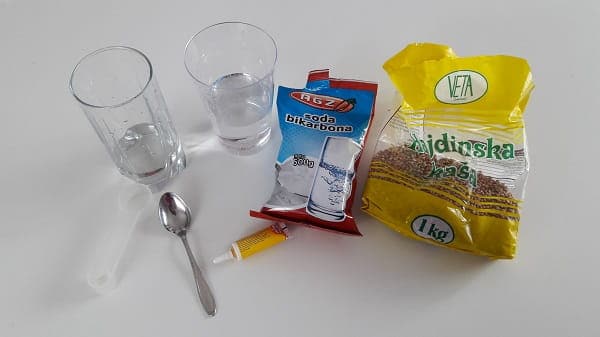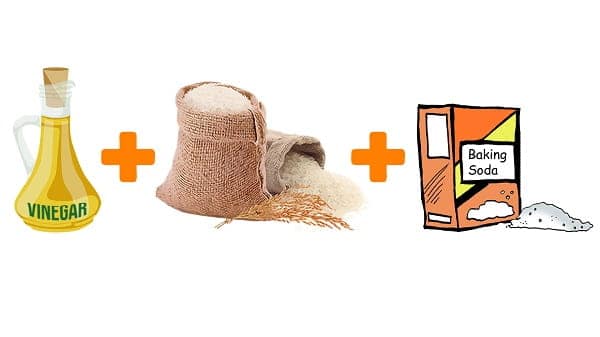Are you in a mood for some dancing? How about some chemistry? Let’s combine the two in this fun kitchen experiment starring grain. With the help of the well-known accomplices baking soda and vinegar, the dancing grain will surely produce a reaction. 🙂
Table Of Contents
1. Science Behind The Dancing Grain Experiment2. Materials Needed For The Dancing Grain Experiment
3. Instructions For Making Dancing Grain Experiment
4. What Will You Develop And Learn
Science Behind The Dancing Grain Experiment
Do you remember the Orange density experiment? There we talked a lot about what determines what sinks and what floats. As the name implies, it’s all about the density. It’s at the play here as well.
When you first drop grain inside the water, it sinks to the bottom. Why? Because it has a higher density (mass per volume) than water. But then, the magic happens.
Vinegar and baking soda react beautifully and quite explosively in what we call an acid-base reaction. Here the baking soda is a base (NaHCO3) and the vinegar (CH3COOH) is acid. Acid is always trying to get rid of the positively charged hydrogen atom (proton) and the base really wants that proton. So naturally, those two quickly get together to accomplish their goals.
When the baking soda gets that coveted proton, it immediately dissolves into water and carbon dioxide. Those tiny bubbles of carbon dioxide get attached to the surface of our grain. Since their weight is insignificant, the mass of the grain stays the same. But the volume gets quite larger. Do you know what that means? Since the density is mass/volume, that means the density gets lower. So much lower that in fact it’s less than the density of the water and the grain rises to the surface.
Here we see the Archimedes’ Principle at work. It states that the buoyant force exerted on a fluid is equal to the weight of the fluid displaced. Now that the grain has a greater volume, it displaces more water and causes the water to exert a greater buoyant force.
When the grain reaches the surface, carbon dioxide escapes in the air and our poor grain loses its transport. Back to the bottom, it goes. This dance lasts for quite a bit of time and it’s mesmerizing to watch.
Materials Needed For The Dancing Grain Experiment
- Water
- Bowl or glass
- Grain (we used buckwheat but you can experiment with rice or barley)
- Baking soda
- Vinegar
- Food coloring (optional)
Instructions For Making Dancing Grain Experiment
For step-by-step instructions on how to conduct this experiment watch the video at the beginning of the article or continue reading.
- Pour the water into the bowl.
- Put one spoon of baking soda.
- Add a fistful of the chosen grain (we used buckwheat).
- Optionally, add some food coloring.
- Add a spoon or two of vinegar.
- Poof! Enjoy watching the grain dancing. It lasts quite some time.
Note:
If the grain is not “dancing” after a minute or two, it is probably too heavy – try with some other (lighter) grain.
What Will You Develop And Learn
- Chemistry principles
- What is an acid-base reaction
- What is density and how to calculate it
- Archimedes’ principle
If you liked this experiment and want something else, give a try to another kitchen experiment. How about exploring the concept of osmosis in Gummy bears osmosis experiment? Or if you have some leftover vinegar and baking soda, try to use it as a propulsion system to this amazing rocket! Or go for another fan favorite – volcano eruption. Whatever you choose, always remember to have fun, be careful and observe closely. Until the next adventure, dance on!
If you’re searching for some great STEM Activities for Kids and Child development tips, you’re in the right place! Check the Categories below to find the right activity for you.

STEM Science
Videos, guides and explanations about STEM Science in a step-by-step way with materials you probably already have at your home. Find new Science ideas.
Read more
STEM Technology
Videos, guides and explanations about STEM Technology in a step-by-step way with materials you probably already have at your home. Find new Technology ideas.
Read more
STEM Engineering
Videos, guides and explanations about STEM Engineering in a step-by-step way with materials you probably already have at your home. New Engineering ideas!
Read more
STEM Math
Videos, guides and explanations about STEM Math in a step-by-step way with materials you probably already have at your home. Find new Mathematics ideas.
Read more
Psychology
Find out all about development psychology topics that you always wanted to know. Here are articles from child psychology and development psychology overall.
Read more
First year of Child’s Life
Following a Child’s development every month from its birth. Personal experiences and tips on how to cope with challenges that you will face in parenting.
Read more


2 thoughts on “How to make a Dancing Grain Experiment”